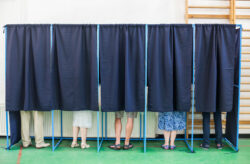Demographic Inversion and the Church
Sam Rainer
The New Republic has an excellent piece on the future gentrification of U.S. cities. Gentrification is a socioeconomic phenomenon in which people of more affluence move into an area that is typified as less affluent. This movement is usually associated with people who move from the suburbs into inner-city areas.
Alan Ehrenhalt, the author of the article, dubs this shift “demographic inversion.” A snippet from his article sums up the point:
…the current inversion is less the result of middle-aged people changing their minds than of young adults expressing different values, habits, and living preferences than their parents. The demographic changes that have taken place in America over the past generation–the increased propensity to remain single, the rise of cohabitation, the much later age at first marriage for those who do marry, the smaller size of families for those who have children, and, at the other end, the rapidly growing number of healthy and active adults in their sixties, seventies, and eighties–have combined virtually all of the significant elements that make a demographic inversion not only possible but likely. We are moving toward a society in which millions of people with substantial earning power or ample savings can live wherever they want, and many will choose central cities over distant suburbs. As they do this, others will find themselves forced to live in less desirable places–now defined as those further from the center of the metropolis. And, as this happens, suburbs that never dreamed of being entry points for immigrants will have to cope with new realities.
This type of talk has been quite popular since rising gas prices monster-trucked the SUV industry. But it’s not so far-fetched in my mind. Even my wife (a country girl) has told me she would rather live close to everything with gas prices so high. But if it occurs, the timeline for this type of demographic shift on a national scale is probably decades-long. And some data do not fully support the notion of large-scale demographic inversion.
Regardless, revitalized downtowns across the U.S. point to some level of gentrification. And there are a few church leaders who are focusing on all people – newcomers to downtown and those families who have lived there for generations. But this possible demographic shift is not discussed enough among church leaders. Even if it occurs on a small-scale, there is a great opportunity for churches on both sides to reach a new group of people – those who are moving into the city, and those who are moving out to the suburbs. My hope is that churches will have open doors, minds, and hearts for what could be great unity in diversity.







Thanks for always doing the research for me and providing this great information. Some day I may repay, probably not though. They are not only seeing a shift among young people to downtown in Dallas but also a movement of renewal and excitment. The rough part of town here have been totally redeveloped to include townhomes for six figures. The problem that I see is that the consumer market has seen this trend but the downtown churches still are struggling to adapt at the rate of change. Instead, new congregations are springing up in areas that 20-30 years ago people were leaving for the suburbs. Sorry to be so long winded.
Jeremy
Jeremy – I don’t know Dallas that well, but I would assume that the downtown has undergone an extensive revitalization. As in other cities, churches have a great opportunity to reach new people in areas that were once boarded up. For the most part, those that are moving in are younger and generally more receptive to spiritual issues (but not necessarily the church).
Church planter Matt Brown (a PCA pastor in Brooklyn) commented on this, specifically with regard to well-meaning Christians’ desire to “force-gentrify” (is that a term?) by moving into urban areas: please don’t!
Apparently, Matt and his cohorts have found that a good number of folks want to revitalize depressed areas and bring the gospel into urban contexts where truth has largely been lost. Understood– but they’ve also found that the net result of this happening on even a moderately large scale doesn’t help as muh as it hurts; housing prices increase, cost of living goes up, and the people who were inhabiting these areas (and sometimes for generations) end up being displaced.
I wonder if the natural gentrification basically has the same effect? And if so, then where do those displaced folks end up?
Ed – good point, I wouldn’t advocate “force-gentrification” (we’ll make it a word). But certainly the gospel can be brought into any context or culture without forcing another culture upon the people. As for where they end up after a neighborhood gentrifies, the article mentioned that they typically go further out from the city.
Wow, this is so interesting! Tim Keller talks a lot about Christians moving into the city b/c that’s where everyone is, and cities create and determine culture for most people on the planet. He thinks we’re most effective in the city.
Very interesting idea indeed!
That’s interesting, Sam. I don’t know about yours, but at my seminary the hip perspective was that urban ministry was the only “serious” ministry context– as Jesse already mentioned, Keller’s perspective has begotten zealous followers who scoff at someone that would consider ministering elsewhere. I can remember one conversation when I was asked what sort of church I would like to pastor; just for grins I said, “oh, maybe a nice suburban church.” This guy was indignant, spending the next five minutes telling me how I was selling out and, essentially, saying he couldn’t respect a ministry in that context. (Because the rich white folks who inhabit the suburbs– as if that’s all there are there– clearly don’t need the gospel.)
What’s so ironic is that, according to what you’re saying, the rich white folks– and others who are the stuff of “gentrification”– are now the very folks the urban pastors will be serving, while the pastors in the suburbs and bedroom communities– like me– will be the ones with the ethnic, racial, and socio-economic diversity in our congregations.
Ed – I went to a Southern Baptist seminary…there were some hip people there, but not many…
You’re correct, there is some irony in the shift of demographics, but I don’t think that the suburbs will be entirely flooded with ethnic, racial, and socioeconomic diversity. Nor will the inner-cities entirely fill up with yuppies. But noticeable shifts are occurring in many areas, particularly in the larger cities.
I just hope that churches attempt to reach their communities better, and thus reflect their communities better (no matter who lives in the neighborhood).
Agreed. Reflecting the communities in which we exist ought to be the norm for a congregation.